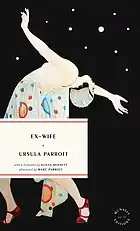Ex-Wife (Ursula Parrott)
Ex-Wife is a 1929 novel written by Ursula Parrott and reissued by McNally Editions in 2023 with an afterword by Marc Parrott, the author's son, and a foreword by Alissa Bennett, a writer for the Paris Review.[1][2][3][4][5][6]
 McNally Editions book jacket | |
| Author | Ursula Parrott |
|---|---|
| Country | United States |
| Subject | Adultery Fiction, Divorce Fiction, Divorced women Fiction, Nineteen twenties Fiction, Self-realization in women Fiction |
| Genre | Novel |
| Published | 1929, 1930, 1989, 2023 |
| Publisher | J. Cape & H. Smith [1929]; Grosset & Dunlap [1930]; New American Library [1989]; McNally Editions [2023]. |
| Media type | Print, E-book, Audio |
| Pages | 210+ |
| ISBN | 9781946022561 9781946022578 |
| OCLC | 1347428967 |
| Website | Publisher's website |
About the book
The book was a commercial success in 1929, and it maintained its success throughout the depression era 1930s, but fell out of print. It was reissued in 1989 and now in 2023. It was originally published anonymously "to underscore the salaciousness of its material."[1][3] Shortly after the book’s publication, the media began hunting for the author's identity, and whether the protagonist’s portrayal was actually fictional, somewhat autobiographical or was critiquing a culture undergoing tectonic shifts.[2] By August 1929, the year of this book's publication, the successful sleuthing revealed the author to be "Katherine Ursula Parrott, a journalist and fashion writer..."[2]
The book also became a tamer-versioned movie, “The Divorcee,” starring Norma Shearer, who won an Oscar for her role. The protagonist, Patricia, has a stressful job as a department store fashion advertising copywriter. Then she exercises at the gym to relieve the stress from work, and pursues "love, money, fun and trouble."[1] Her night life becomes immersed in and surrounded by Speakeasys, wine, beer, gin fizzes, martinis, high balls, and Alexanders, another name for Clover Club cocktails.
Synopsis
A young woman named Patricia finds herself in the ambiguous space between marriage and divorce.[2] The novel is set in New York City during the Jazz Age, and it explores the themes of female independence, sexual liberation, and the changing social mores of the time. A thread that runs throughout the story for Patricia is profound loss resulting in loneliness. After Patricia's open marriage fails, alcohol induced binges, multiple one night stands, and affairs become a mainstay.[1][2] There is also the cultural dissonance between Victorian morality, carried into the new century, and the emerging sexual freedom that encompasses the permissibility of casual sex.[2][3] Also, as a distraction from her devastating losses, Patricia "buys clothes she can’t afford; she gets facials and has her hair done; she listens to songs on repeat while wearily wondering why heartache always seems to bookend love."[2]
References
- Jacobs, Alexandra (30 April 2023). "She Wrote Frankly About Divorce, and Suffered the Consequences". New York Times.
- Bennett, Alissa (21 April 2023). "Divorcée Fiction: On Ursula Parrott". Paris Review.
- Oates, Joyce Carol (July 2023). "None-Too-Gay Divorcées". The New York Review of Books.
- Winter, Jessica (3 May 2023). "The Divorce Novel That Captured the Mores of Jazz Age New York". The New Yorker.
- Raub, Patricia (1994). "A New Woman or an Old-Fashioned Girl? The Portrayal of the Heroine in Popular Women's Novels of the Twenties". American Studies. 35 (1): 109–130. JSTOR 40642587. "Ex-Wife" is discussed on pages 118-119
- Fletcher, Jessica (July 10, 2023). "The Dark Side of the Jazz Age". The Baffler. Retrieved August 9, 2023.
Further reading
- Gordon, Marsha (April 2023). Becoming the Ex-Wife: The Unconventional Life and Forgotten Writings of Ursula Parrott. University of California Press. ISBN 9780520391543. 312 pages. OCLC 1346147854.
External links
- Official website
- Simon & Schuster (distributor).
- Vintage 1930 "Ex-Wife" book images.